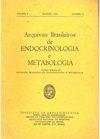Diagnosis, treatment, and follow-up of medullary thyroid carcinoma: recommendations by the Thyroid Department of the Brazilian Society of Endocrinology and Metabolism.
Arquivos brasileiros de endocrinologia e metabologia
Pub Date : 2014-10-01
DOI:10.1590/0004-2730000003427
引用次数: 32
Abstract
INTRODUCTION Medullary thyroid carcinoma (MTC) originates in the thyroid parafollicular cells and represents 3-4% of the malignant neoplasms that affect this gland. Approximately 25% of these cases are hereditary due to activating mutations in the REarranged during Transfection (RET) proto-oncogene. The course of MTC is indolent, and survival rates depend on the tumor stage at diagnosis. The present article describes clinical evidence-based guidelines for the diagnosis, treatment, and follow-up of MTC. OBJECTIVE The aim of the consensus described herein, which was elaborated by Brazilian experts and sponsored by the Thyroid Department of the Brazilian Society of Endocrinology and Metabolism, was to discuss the diagnosis, treatment, and follow-up of individuals with MTC in accordance with the latest evidence reported in the literature. MATERIALS AND METHODS After clinical questions were elaborated, the available literature was initially surveyed for evidence in the MedLine-PubMed database, followed by the Embase and Scientific Electronic Library Online/Latin American and Caribbean Health Science Literature (SciELO/Lilacs) databases. The strength of evidence was assessed according to the Oxford classification of evidence levels, which is based on study design, and the best evidence available for each question was selected. RESULTS Eleven questions corresponded to MTC diagnosis, 8 corresponded to its surgical treatment, and 13 corresponded to follow-up, for a total of 32 recommendations. The present article discusses the clinical and molecular diagnosis, initial surgical treatment, and postoperative management of MTC, as well as the therapeutic options for metastatic disease. CONCLUSIONS MTC should be suspected in individuals who present with thyroid nodules and family histories of MTC, associations with pheochromocytoma and hyperparathyroidism, and/or typical phenotypic characteristics such as ganglioneuromatosis and Marfanoid habitus. Fine-needle nodule aspiration, serum calcitonin measurements, and anatomical-pathological examinations are useful for diagnostic confirmation. Surgery represents the only curative therapeutic strategy. The therapeutic options for metastatic disease remain limited and are restricted to disease control. Judicious postoperative assessments that focus on the identification of residual or recurrent disease are of paramount importance when defining the follow-up and later therapeutic management strategies.甲状腺髓样癌的诊断、治疗和随访:巴西内分泌与代谢学会甲状腺科的建议
简介:甲状腺髓样癌(MTC)起源于甲状腺滤泡旁细胞,占甲状腺恶性肿瘤的3-4%。大约25%的病例是遗传性的,由于转染(RET)原癌基因重排时激活突变。MTC病程缓慢,生存率取决于诊断时的肿瘤分期。本文介绍临床循证指南的诊断,治疗和随访的MTC。目的:本文所述的共识是由巴西专家详细阐述并由巴西内分泌与代谢学会甲状腺科赞助的,目的是根据文献中报道的最新证据讨论MTC患者的诊断、治疗和随访。材料和方法:在详细阐述临床问题后,首先在MedLine-PubMed数据库中调查现有文献,然后在Embase和科学电子图书馆在线/拉丁美洲和加勒比卫生科学文献(SciELO/Lilacs)数据库中调查证据。根据基于研究设计的牛津证据水平分类来评估证据的强度,并为每个问题选择最佳证据。结果:与MTC诊断相关的问题有11个,与手术治疗相关的问题有8个,与随访相关的问题有13个,共计32条建议。本文讨论了MTC的临床和分子诊断、初始手术治疗和术后管理,以及转移性疾病的治疗选择。结论:在有甲状腺结节和MTC家族史、与嗜铬细胞瘤和甲状旁腺功能亢进相关和/或典型表型特征(如神经节神经瘤病和类马氏体质)的个体中应怀疑MTC。细针结节抽吸、血清降钙素测定和解剖病理检查可用于诊断确认。手术是唯一的治疗策略。转移性疾病的治疗选择仍然有限,仅限于疾病控制。在确定随访和后期治疗管理策略时,关注残留或复发疾病的明智的术后评估至关重要。
本文章由计算机程序翻译,如有差异,请以英文原文为准。
求助全文
约1分钟内获得全文
求助全文

 求助内容:
求助内容: 应助结果提醒方式:
应助结果提醒方式:


